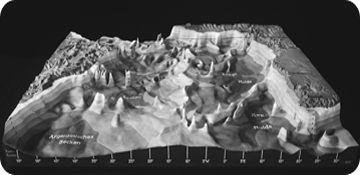One of the world’s longest mountain ranges twists it way down the center of the Atlantic Ocean -- the Mid-Atlantic Ridge. Its peaks can tower up to two miles high, and they’re separated by steep-sided canyons. The ridge marks the boundary between oceanic plates, where hot rock is pushing up from far below the ocean floor to make new crust.
 A 3-dimensional view of the equatorial Atlantic seafloor. The Mid-Atlantic Ridge snakes down the middle of the Atlantic Ocean between Brazil on the left and Africa on the right. Credit: National Oceanic and Atmospheric Administration
A 3-dimensional view of the equatorial Atlantic seafloor. The Mid-Atlantic Ridge snakes down the middle of the Atlantic Ocean between Brazil on the left and Africa on the right. Credit: National Oceanic and Atmospheric AdministrationThere’s growing evidence that the waters above the Mid-Atlantic Ridge are teeming with life.
Scientists have studied the ridge carefully over the last few years -- especially its northern sections. Expeditions have profiled the entire water column -- from the surface to the bottom -- to find out what lives above the ridge. They’re also studying how life above the ridge compares to surrounding areas of the Atlantic.
A 2004 expedition found surprisingly large numbers of dolphins, whales, and birds above the ridge. Other observations have shown abundant supplies of phytoplankton -- microscopic plants near the surface that form the first link in the food chain.
Currents of warm water flow above the ridge, while cold water flows deep, through its canyons. The cold water carries abundant nutrients, and pushes them up close to the surface. That may create a good environment for plankton -- and where there’s plankton, other life follows. Dead organisms from the surface drift down, providing food for bottom-dwellers, too.
So one of the most dynamic geological formations on Earth may nurture a dynamic web of life.

